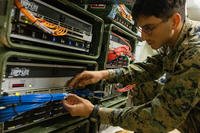For many veterans, even those with GI Bill benefits, the price of going to a traditional four-year university can come with extreme sticker shock.
Paying potentially tens of thousands of dollars over four (or more) years to study for a degree that doesn't even guarantee a job in the field can seem like a risky bet for separating veterans.
"Some people think if you have the GI Bill, you should be in school full time," William Hubbard, the chief of staff for Student Veterans of America, told The New York Times. "That is true if you are a 25-year-old single person with no obligations. But most people have families, work full time and are nontraditional students."
For many veterans who spent years in the military developing skills with hands-on training, "nontraditional" means lacking interest in taking classes in a university setting to get an office job they may not even want -- or be able to get in a competitive market.
But there is another way forward: vocational training.
Read: Vocational Training with Your GI Bill
In the 1980s and 1990s, skilled trades and vocational schools experienced a large dip in enrollments, as baby boomers impressed the importance of higher education on younger generations, according to the National Center for Education Statistics.
A PBS NewsHour story in 2017 found that the dip in vocational school enrollment came from a "decades-long" push toward college enrollment. Now, 40 years later, that dip is leading to what some foresee as a dearth of talent in skilled trades.
"The last Department of Labor study in 2013 found that the median age of America's advanced manufacturing employee was 59 years old," said Hernan Luis y Prado, founder of San Diego-based Workshops for Warriors, a nonprofit that trains veterans in skilled trades. "In six or seven years, they'll be exiting the workforce and taking those manufacturing skills with them, something I call the 'Silver Tsunami.'"
Luis y Prado estimates that the number of advanced manufacturing jobs left unfilled will balloon to 3.4 million within the next decade, a need that creates opportunities for separating veterans, along with another 30 million jobs that require certifications, but not a bachelor's degree.
The reason veterans aren't flocking to skilled trades may be because of the social stigma of going to a vocational school instead of a four-year university program.
In many school districts, lower-performing students considered unsuited for an academic environment were pushed into vocational education in "declining industries," according to Georgetown University professors Harry Holzer and Sandy Baum. That push didn't translate to better outcomes for students, employers or the U.S. economy.
Another misconception about skilled trades is that the pay is significantly lower than a job requiring a bachelor's degree. In reality, according to a 2019 study from the U.S. Census Bureau, skilled earners make as much or more than the U.S. national average of $61,000.
Incomes in larger cities and for specialized trades can be even higher, with many earning more than six-figure salaries, all without ever taking out a student loan.
-- Blake Stilwell can be reached at blake.stilwell@military.com. He can also be found on Twitter @blakestilwell or on Facebook.
Want to Know More About Veteran Jobs?
Be sure to get the latest news about post-military careers, as well as critical info about veteran jobs and all the benefits of service. Subscribe to Military.com and receive customized updates delivered straight to your inbox.












